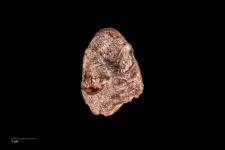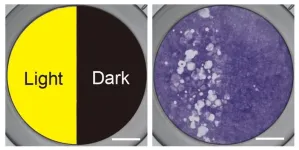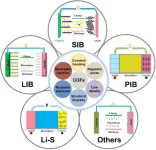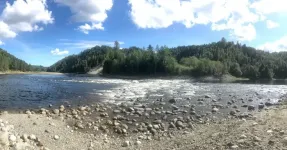(Press-News.org) Scientists have uncovered the fossilized skull of a 270-million-year-old ancient amphibian ancestor in the collection of the Smithsonian’s National Museum of Natural History. In a paper published today, March 21, in the Zoological Journal of the Linnean Society, the team of researchers described the fossil as a new species of proto-amphibian, which they named Kermitops gratus in honor of the iconic Muppet, Kermit the Frog.
According to Calvin So, a doctoral student at the George Washington University and the lead author on the new paper, naming the new creature after the beloved frog character, who was created by puppeteer Jim Henson in 1955, is an opportunity to get people excited about the discoveries scientists make using museum collections.
“Using the name Kermit has significant implications for how we can bridge the science that is done by paleontologists in museums to the general public,” So said. “Because this animal is a distant relative of today’s amphibians, and Kermit is a modern-day amphibian icon, it was the perfect name for it.”
The fossilized skull—which measures just over an inch long and possesses large, oval-shaped eye sockets—was originally unearthed by the late paleontologist Nicholas Hotton III, who served as a curator in the museum’s paleobiology department for nearly 40 years. Hotton spent several field seasons excavating fossils from rock outcrops in north central Texas known as the Red Beds. The area’s rust-colored rocks date back to the early Permian period more than 270 million years ago and contain the fossilized remains of ancient reptiles, amphibians and sail-backed synapsids, the precursors to modern mammals.
Hotton and his team collected so many fossils that they were not able to study all of them in detail. This included a small proto-amphibian skull, which the team had unearthed in a rock layer known as the Clear Fork Formation in 1984. The skull was deposited in the Smithsonian’s National Fossil Collection, where it spent decades waiting for a researcher to take a closer look.
In 2021, Arjan Mann, a postdoctoral paleontologist at the museum and a former Peter Buck Fellow, was sifting through Hotton’s trove of Texas fossils when one specimen labeled as an early amphibian caught his eye.
“One fossil immediately jumped out at me—this really well preserved, mostly prepared skull,” said Mann, who serves as So’s mentor and is also a co-author on the new paper.
Mann and So teamed up to determine what kind of prehistoric creature the fossil belonged to. The skull possessed a mishmash of traits that were different from features seen in the skulls of older tetrapods, the ancient ancestors of amphibians and other living four-legged vertebrates. For example, the region of the skull behind the animal’s eyes was much shorter than its elongated, curved snout. These skull proportions helped the animal, which likely resembled a stout salamander, snap up tiny grub-like insects.
The researchers identified the fossil as a temnospondyl, a diverse group of primitive amphibian relatives that lived for over 200 million years from the Carboniferous to the Triassic periods. But because the animal’s skull sported such unique features, the scientists concluded that it belonged in an entirely new genus, which they named Kermitops. The moniker is a play on the creature’s cartoonishly wide-eyed face and is derived from a mashup of the words “Kermit” and the Greek suffix “-ops,” which means face. The researchers also christened the new animal with the species name gratus to represent their gratitude for Hotton and the rest of the team that originally unearthed the fossil.
Kermitops is notable for more than just its namesake puppet persona. The early fossil record of amphibians and their ancestors is largely fragmentary, which makes it difficult to understand how frogs, salamanders and their kin originated. Adding relatives like Kermitops into the fold is essential for fleshing out the early branches of the amphibian family tree.
“Kermitops offers us clues to bridge this huge fossil gap and start to see how frogs and salamanders developed these really specialized traits,” So said.
Mann agrees and hopes that the discovery of a previously unknown amphibian ancestor hiding in plain site will inspire other paleontologists to take a closer look at their own museum’s fossil collections.
“This is an active area of research that a lot more paleontologists need to dive back into,” Mann said. “Paleontology is always more than just dinosaurs, and there are lots of cool evolutionary stories and mysteries still waiting to be answered. We just need to keep looking.”
The new project is the latest example of the Smithsonian’s history of collaboration with George Washington University. This collaboration provides the university’s students with access to the collections and resources of the world’s largest museum and research complex. The new paper also includes a coauthor from the Field Museum of Natural History.
About the National Museum of Natural History
The National Museum of Natural History is connecting people everywhere with Earth’s unfolding story. It is one of the most visited natural history museums in the world. Opened in 1910, the museum is dedicated to maintaining and preserving the world’s most extensive collection of natural history specimens and human artifacts. The museum is open daily, except Dec. 25, from 10 a.m. to 5:30 p.m. Admission is free. For more information, visit the museum on its website, blog, Facebook, Twitter and Instagram.
# # #
END
Cold Spring Harbor Laboratory Associate Professor and Cancer Center member Tobias Janowitz led a COVID-19 clinical trial with Northwell Health in 2021. When he and Clinical Fellow Hassal Lee reviewed the data, a surprising trend emerged. “The patient roster was very diverse,” Janowitz explains. “We’d made no deliberate effort toward that other than conducting the trial remotely.”
When it comes to cancer trials, many variables impact patient participation. One measurable factor is distance. On average, people are less likely to ...
About The Study: This analysis including 157,000 individuals from two large study cohorts found that among U.S. veterans, higher body mass index (BMI) variability was a significant risk marker associated with adverse cardiovascular events independent of mean BMI across major racial and ethnic groups. Results were consistent in the UK Biobank for the cardiovascular death end point. Further studies should investigate the phenotype of high BMI variability.
Authors: Yan V. Sun, Ph.D., M.S., ...
About The Study: In this early childhood study including 303 children, concussion was associated with more postconcussive symptoms than orthopedic injuries or typical development up to three months after injury. Given the limited verbal and cognitive abilities typical of early childhood, using developmentally appropriate manifestations and behaviors is a valuable way of tracking postconcussive symptoms and could aid in concussion diagnosis in young children.
Authors: Miriam Beauchamp, Ph.D., of the Universite de Montreal, is the corresponding author.
To access the embargoed study: Visit our For The Media website at ...
The first study of humpback whale entanglements in B.C. aquaculture facilities in PLOS One found eight over 13 years, with the curiosity of young whales a potential contributing factor.
A rare occurrence
Entanglements are one of several threats to humpbacks. The eight occurred from 2008 to 2021 at seven fish farms, with five animals successfully released and three deaths. The entanglements accounted for less than six per cent of all entanglements in B.C. Approximately 7,000 animals return to B.C. waters annually.
Most whales became entangled between the predator and containment nets on fish farms. In five cases, experienced ...
Tokyo, Japan – Drinking milk helps your bones grow big and strong; but what if direct exposure to light could help too? Now, researchers from Japan report that lighting up bone tissue could help treat bone disease.
In a study published last month in Scientific Reports, researchers from Tokyo Medical and Dental University (TMDU) have revealed that a treatment approach based on light could help activate bones to repair themselves.
Bones are constantly being remodeled through the action of osteoclasts, which break down bone tissue, and osteoblasts, which create new bone tissue. ...
We are used to computers getting faster and faster, but complicated calculations involving lots of data can take a very long time, even today.
This applies to calculations of chemical reactions, how proteins assume different three-dimensional forms and so-called phase transitions, where one chemical substance transitions from one state to another, such as from solid to liquid form.
These types of results are often very important – for example, in the chemical industry.
Down from one year to ten days
These complicated calculations can take years to perform, and access to the most ...
1. A NIMS research team has developed a technique that enables the nanoscale observation of heat propagation paths and behavior within material specimens. This was achieved using a scanning transmission electron microscope (STEM) capable of emitting a pulsed electron beam and a nanosized thermocouple—a high-precision temperature measurement device developed by NIMS.
2. Public interest in energy conservation and recycling has grown considerably in recent years. This change has inspired scientists to develop next-generation materials/devices capable of controlling and utilizing heat with a high degree of precision, including thermoelectric devices able to ...
They published their work on Mar. 15th in Energy Material Advances.
"It is highly necessary to design highly conductive and high-performance materials for application in alkaline ion batteries," said paper author Xijun Xu, associate Professor at the College of Chemical Engineering and Light Industry, Guangdong University of Technology.
"In recent years, with the development of large-scale power systems such as electric vehicles, the demand for secondary batteries has gradually shifted towards high power and low cost. Furthermore, in light of the increasing energy and environmental concerns, the exploration of green and renewable ...
They published their work on Mar. 15th in Energy Material Advances.
"The development of cost-effective and high-performance RP anode materials for LIBs/SIBs is imperative," said paper author Hailei Zhao, professor with the Beijing Key Lab of New Energy Materials and Technology, School of Materials Science and Engineering, University of Science and Technology Beijing, "Despite RP shows a great potential, the inherent poor electrical conductivity of RP (~10-14 S cm-1) and significant volume changes during charge/discharge processes (> 300%) compromise its cycling stability."
Zhao explained that the poor electrical conductivity ...
In a Finnish outcrop nestled between some of Northern Europe's oldest mountains, researchers have found traces of a previously hidden part of Earth's crust that points more than three billion years back in time and north towards Greenland.
These traces were found in the mineral zircon, which after chemical analyses, indicated to researchers from the Department of Geosciences and Natural Resource Management that the "foundation" upon which Denmark and Scandinavia rest, was probably 'born' from Greenland approximately 3.75 billion years ago.
"Our data suggest that the oldest part of Earth's crust beneath Scandinavia originates ...







